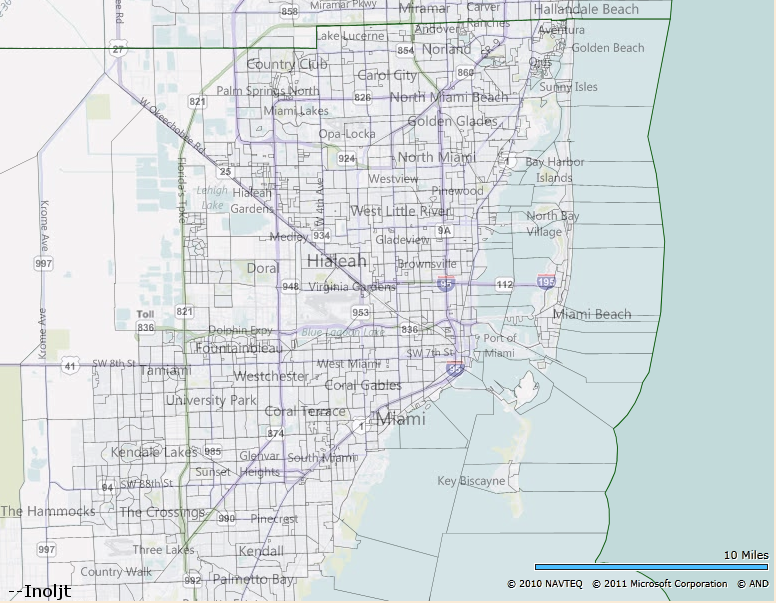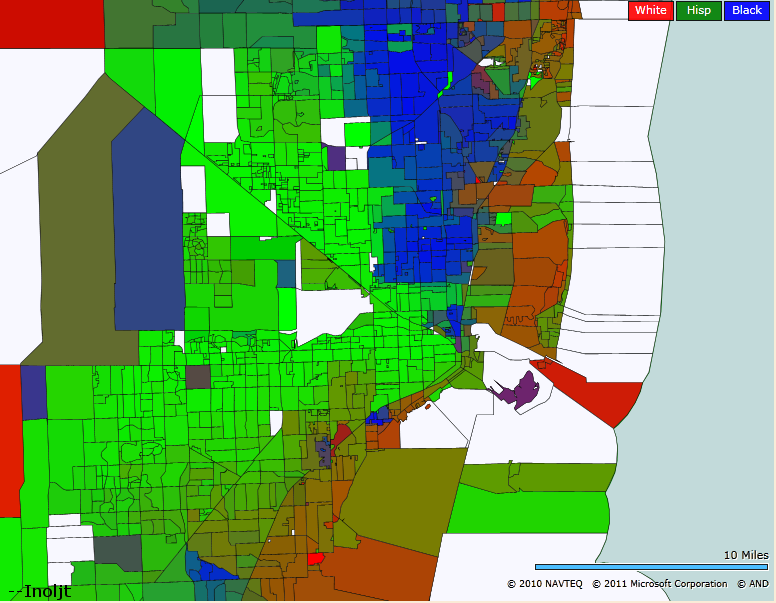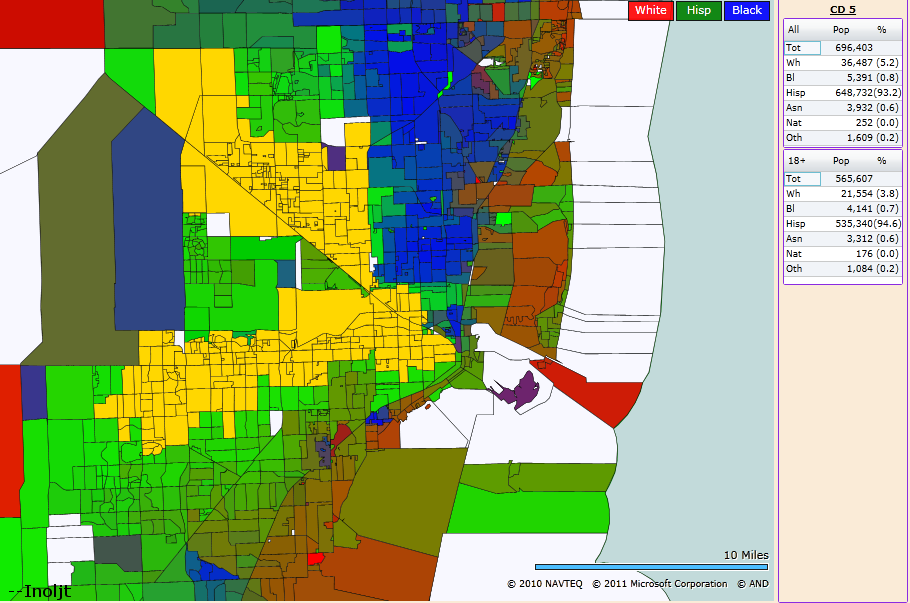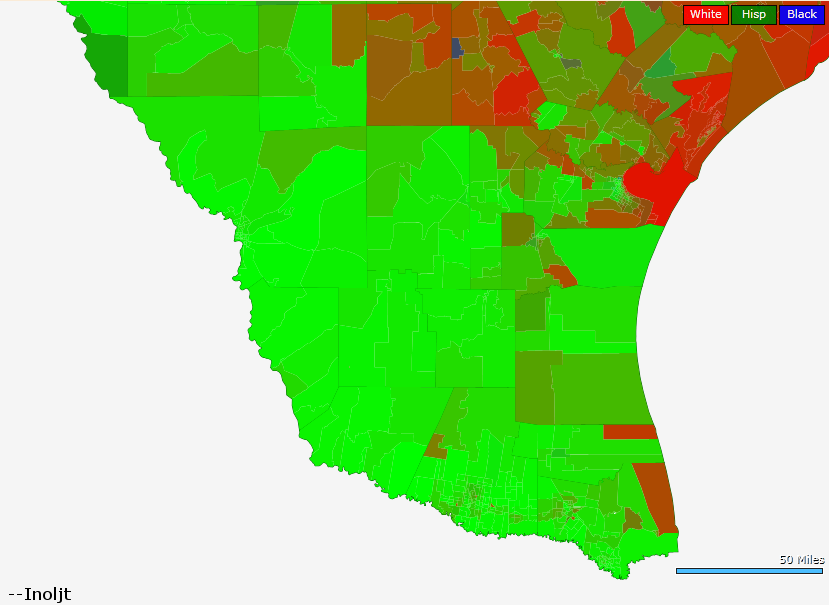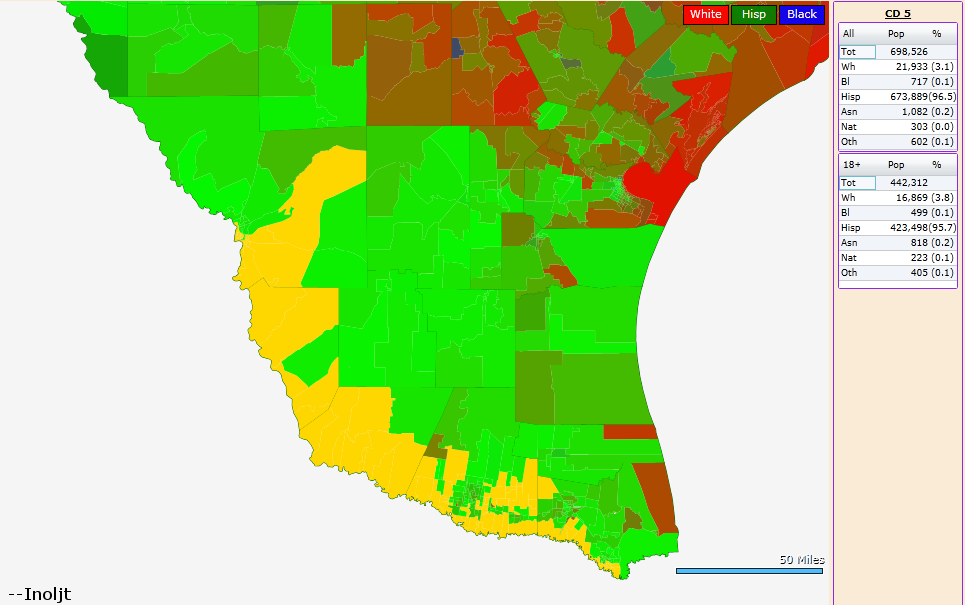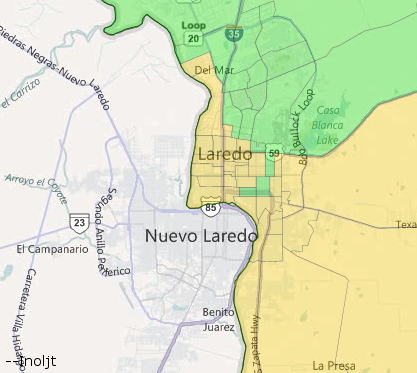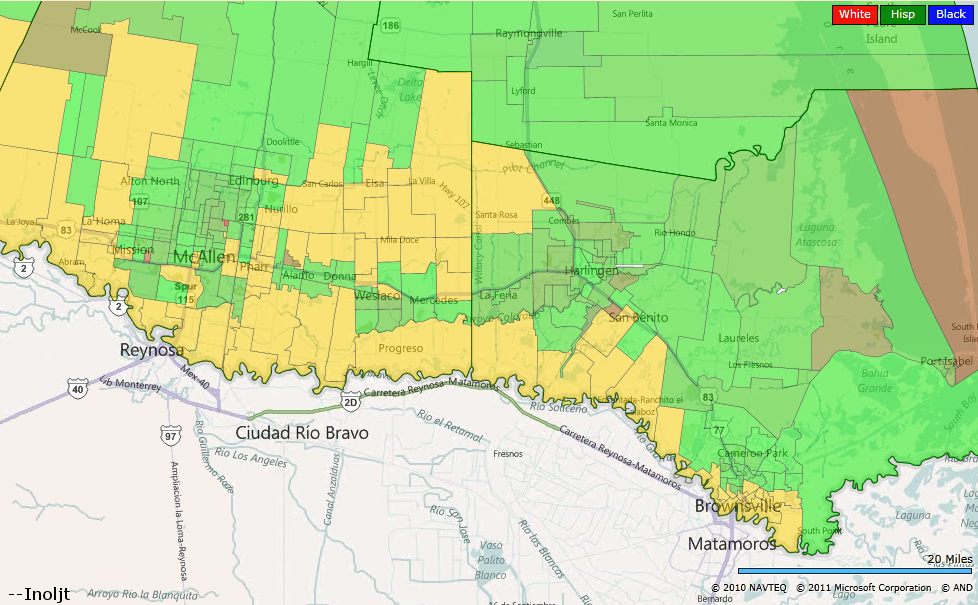This is the second part in a series of posts examining how to create super-packed congressional districts of one race. The other posts in this series pack Asians, blacks, Native Americans, and whites.
Packing Hispanics
The previous post created a 94.8% black congressional district, carved out of Chicago.
Chicago is probably the only place in America where such a district can be created. Only Chicago has sufficient numbers of blacks and sufficient levels of segregation.
This is not true for Hispanics. It is a lot easier to pack Hispanics. This because there are simply more Hispanics than blacks in the United States.
More below.
Hispanic living patterns are also rather different than black living patterns. There are often sharp lines between black and non-black neighborhoods; one can cross a street and suddenly go from an 80% white neighborhood to an 80% black one. This makes it easy to draw a 90%-black district – at least until the 90% black precincts run out.
Hispanic neighborhoods, on the other hand, tend to become Hispanic more gradually. One precinct may be 10% Hispanic, the next one 30% Hispanic, the one after that 50% Hispanic, and the center of the neighborhood 80% Hispanic.
To create an extremely Hispanic congressional district, one needs a 95% Hispanic neighborhood – or city, really – big enough to fill an entire congressional district.
There are three such places in America: Miami, Los Angeles, and South Texas.
Miami
Miami is home to one of the most diverse and concentrated population of Hispanics in the United States. Unlike many areas, most Hispanics here tend to be Cuban or from areas outside of Mexico.
Currently this area elects three Hispanic Republicans to Congress. Let’s take a look at the demographics:
There is more than enough room here to create an extremely Hispanic district, by taking in the most Hispanic precincts in this area. There will then still be enough Hispanics left to probably create another Hispanic-majority seat.
Here is the district:
This is a 93.2% Hispanic district, located in the heart of Miami. The V-shaped district swerves southeast and then west, avoiding several 80% Hispanic precincts in the middle to take in 95% Hispanic precincts. Interestingly, the adult population is more Hispanic than the overall population – something one rarely sees with Hispanics.
This district almost certainly votes strongly Republican. The representatives currently in its vicinity are all Hispanic Republicans. It’s hard to know for certain its exact political balance; the numbers aren’t there, and the data doesn’t distinguish between Cuban Hispanics (strongly Republican) and non-Cuban Hispanics (who vote Democratic). I’ll go out on a wild guess and say that President Barack Obama got 42% of the vote here.
(Edit: Numbers for Florida have now come out, and my guess was a bit off. Mr. Obama took 36.2% of the vote, while Mr. McCain took 63.8% of the vote.)
Los Angeles
Unfortunately, Dave’s Redistricting Application – the program used to generate these districts – lacks sufficiently detailed 2010 data for California to pack Hispanics effectively.
Nevertheless, the center of Los Angeles constitutes one of the greatest concentrations of Hispanics in America. Most of these Hispanics are of Mexican origin, and the center of the city is almost 100% Hispanic. Indeed, it is very difficult to not draw an 80% Hispanic district in this area.
A 95% or so Hispanic district in the heart of Los Angeles would constitute a Democratic stronghold. Judging from the behavior of individual precincts, such a congressional district probably would give Mr. Obama 80-85% of the vote.
South Texas
Located next to the Mexican border, South Texas is likely the most Hispanic part of the United States:
There are a lot of ways to draw a strongly Hispanic district here. On the other hand, there are several limitations. The most problematic is the Mexican border. If one draws a district along the Mexican border, one has to include all the precincts along it – otherwise a precinct may be trapped with no way to connect to another district. This is generally not a problem in maintaining Hispanic percentages, but occasionally one runs into 75% Hispanic precincts, rather than 95% Hispanic ones.
Nevertheless, after several experiments drawing a district along the border does seem to be the best way to pack Hispanics. Here is the result:
This district tries to include only precincts which are more than 95% Hispanic. The result is a 96.5% Hispanic congressional district.
As a gerrymander, this district encompasses both extremely rural and urban Hispanic areas. The cities are hard to picture clearly, so here are some detailed views.
Here is Laredo (located at the northernmost point along the border):
Here is the Rio Grande Valley:
It is also possible to find almost exactly how liberal this congressional district is, since Dave’s Redistricting Application gives precinct-by-precinct numbers on how Texas voted in 2008. As it turns out, this district gave Mr. Obama 80% of the vote and Senator John McCain 20% in the 2008 presidential election.
This is not, in fact, representative at all of South Texas. The region is much more conservative than these numbers suggest. For some strange reason, while 95+% Hispanic areas vote 80% Democratic, 80% Hispanic areas only vote 60% Democratic in this area. This is either because Hispanics in more integrated areas vote more Republican, or Hispanic turn-out is so low (and whites so strongly Republican) that even a 20% white area in South Texas will have a 40%-white electorate – or it could be both. The data isn’t there to evaluate which hypothesis is true. Whatever the case, it is actually possible to create a 68% Hispanic congressional district which gave Senator John McCain 52% of the vote.
Packing Whites
This post has shown above that one can create a 96.5% Hispanic district, when Hispanics compose only 16.3% of America’s population. Non-Hispanic whites, on the other hand, are more than 60% of the U.S. population. How white, then, can one make a congressional district?
The next post will attempt to pack as many whites as possible into one congressional district – a task which is a lot harder than it seems.
Editor’s Note: In fact, packing whites is turning out to be so time-consuming that I did a post on Asians first.
–Inoljt
